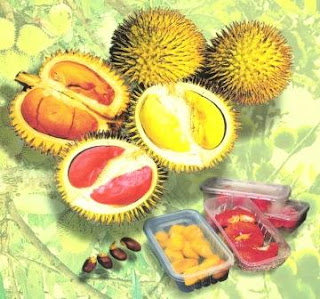Unique Brunei Durians
 During the end of a meeting yesterday, my senior colleague was talking about an old friend of his, now very much his junior, who is based in Bangar, Temburong. My senior colleague was talking about that friend getting him Durian Senokoh which he said is very nice. I am not much of a local durian connoisseur but I am pretty sure I have not come across that particular name. So I looked through my collection of durian books – I have a few, believe it or not. My brother in law used to head the agriculture agency and he gave me quite a few books on agriculture during his tenure.
During the end of a meeting yesterday, my senior colleague was talking about an old friend of his, now very much his junior, who is based in Bangar, Temburong. My senior colleague was talking about that friend getting him Durian Senokoh which he said is very nice. I am not much of a local durian connoisseur but I am pretty sure I have not come across that particular name. So I looked through my collection of durian books – I have a few, believe it or not. My brother in law used to head the agriculture agency and he gave me quite a few books on agriculture during his tenure.There are indeed many Durian species in Brunei – both the white ones and the yellow ones. The white durians (scientific name D. Zibethinus) are generally imported from Malaysia and Thailand. The yellow ones are apparently Brunei’s specialties. The most common is the Durian Otak Udang Galah (D. graveolens Becc.) whose colour is highly variable and ranges from greenish, brownish yellow to yellow. The pulp has a range of colours from yellow to crimson red with all hues of oranges in between. The seeds are quite large, oval, brown in colour and glossy.
 One rather unusual durian in Brunei is one which bears the durian fruits on the main trunks in compact clusters close to the ground. Most durians are fairly high up on the tree and one usually waits for them to fall but not Durian kura-kura (D. testudinarium Becc.) which bears the fruits at the trunk of the tree. The fruits are ovoid, green when young and yellowish brown at maturity and with widely spaced sharp and stout spines. The sweet and strongly aromatic aril (fruit inside) is faint yellow in colour.
One rather unusual durian in Brunei is one which bears the durian fruits on the main trunks in compact clusters close to the ground. Most durians are fairly high up on the tree and one usually waits for them to fall but not Durian kura-kura (D. testudinarium Becc.) which bears the fruits at the trunk of the tree. The fruits are ovoid, green when young and yellowish brown at maturity and with widely spaced sharp and stout spines. The sweet and strongly aromatic aril (fruit inside) is faint yellow in colour.Other durians include the small Durian Sukang (D. oxleyanus Griffith) whose aril is usually corn-yellow, smooth and sweet with a strong fragrance. Durian pulu (D. kutejensis Becc.) is much bigger and considered attractive with crimson coloured petals. The spines on the fruit is softer. Durian meragang (D. dulcis) is rare and only found in the interior jungle regions. The furits are packed with sharp red spines with a dark tip. Some other durians are hybrid such as Durian siunggong (probably a hybrid between D. zibethinus and D. graveolens). There are a great number of durians whose names do not match up with those of the ‘official’ durians in the book. Some include the Durian Senokoh as I mentioned earlier and another one which we sometimes buy called Durian Kepala Ambok (Monkey’s Head). The local names are probably variants of the species or variations of the names the durians.
From what I read, it seemed that Brunei Darussalam has the competitive edge to specialize in unique durian specie particularly the durian kuning species and Durian Pulu for the niche market. Something else to think about in this Kingdom of Unexpected Treasures.

Comments
The temaga (red banana) and kembayau are other fruits that may be native only to Brunei. How cool!
http://members.virtualtourist.com/m/tt/5c34a/#TL for tips on choosing the perfect durian. bon appetit